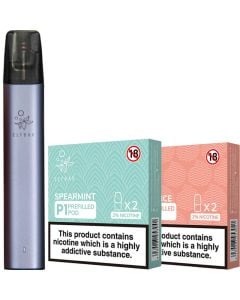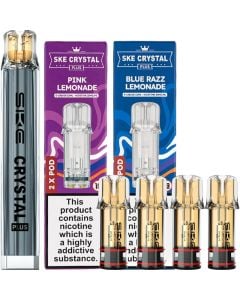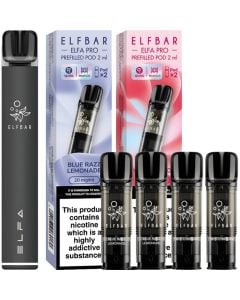NICE (The National Institute for Health & Care Excellence) have recently published their guidance for preventing the uptake of smoking and helping smokers to quit. They have strongly backed e-cigarettes as an effective stop smoking aid.
E-cigarettes as a stop smoking tool
The NICE guidance advises that e-cigarettes are known to be as effective as other NRTs that are medically licensed and offered routinely at stop-smoking clinics and other services. Therefore, they recommend that e-cigarettes should also be offered by these services, as they would likely help many more people make a successful stop smoking attempt. In order for this to be achieved, stop-smoking services will need to be fully informed about vaping.
E-cigarettes have been identified by Public Health England to be 95% less harmful than smoking. The MHRA, the governing body for nicotine containing vaping products, continue to monitor both the short and long term harms of vaping and as of March 2020 have reported 'no major concerns had been identified'.
Alongside how to use an e-cigarette and their benefits as a stop smoking aid, NICE advise that e-cigarette training for stop-smoking practitioners should include advising the patient on finding the correct strength e-liquid. This is to avoid them not getting enough nicotine to satisfy their cravings.
There are already schemes in place in some areas, where e-cigarette starter kits or vouchers are offered to patients who are interested in making the switch to vaping. These schemes have been successful and clinics have found them to be just as effective, if not more so, than NRTs like gum and patches.
Something that the guidance strongly expresses is that these services should be patient led, with practitioners discussing if the patient has a preferred solution already in mind and helping them find a nicotine replacement that best suits their individual needs. While they recognise that offering advice on e-cigarettes may mean some appointments take longer than they may have previously, it is likely this will lead to more successful quit attempts, so offering this advice may actually lead to patients needing fewer appointments.
It is important to bear in mind that all NRTs and e-cigarettes are most effective when used in conjunction with behavioural support.
Protecting young people
E-cigarette use among young people has not proven to be a problem in the UK like it is in the USA. The UK has consistently low rates of regular e-cigarette usage among young people, and regular use is seen almost exclusively in those who were previously or are currently smokers.
These low rates are testament to how well e-cigarettes have been regulated and embraced for their intended purpose in the UK. However, it is important that we do not make e-cigarettes more desirable in the process of encouraging adult smokers to consider them as a stop smoking aid.
We already have a number of measures in place to prevent the sale of vaping products to minors, for example, here at Evapo we operate a strict ‘Think 25’ policy. This means anyone lucky enough to look under the age of 25 will be asked to show ID before purchase to ensure they are of the legal age to buy the products.
The NICE guidance recommends that school-based intervention to inform young people about e-cigarettes, and why they are only recommended for use among adult smokers as a nicotine replacement tool will also be crucial to spreading the correct information. This includes adding information on vaping into the curriculum, similar to how this has been done with smoking. It is however important to recognise the difference between tobacco and e-cigarettes. While it is important to inform young people about why e-cigarettes, we need to do so in a way that lets them understand that any adults in their life who have chosen to make the switch to vaping have made a switch to a less harmful alternative, in the interest of their health and other factors.
Research recommendations
The NICE guidance offers recommendations for areas in which future research around e-cigarettes should focus. These includes more up to date data on the use of e-cigarettes during pregnancy.
Many of the studies into the effectiveness of using a nicotine containing e-cigarette during pregnancy are outdated, being over 10 years old. More research is needed in this area to identify what type of stop smoking aid is most effective for pregnant women, including the nicotine doses that would be needed to effectively satisfy their cravings.
NICE’s Centre for Guidelines director Dr Paul Chrisp said:
“We know that around 10% of women are known to be smokers at the time of giving birth and, given the significant health effects of smoking on both mothers and babies, it is clear that further efforts are required to encourage this group to give up smoking.”
In order to best advise these women, we need to know the best course of action to help them quit in an effective and safe way.
They also advise that more research is needed into the effectiveness of dual usage. This is when a person uses an e-cigarette alongside smoking as a way to cut down on their tobacco use. It is known that any amount of smoking is bad for you, but as a number of vaper’s identify as dual users, we need more data on how effective nicotine containing e-cigarettes are when used alongside tobacco.
With this guidance from NICE, the APPG report and the recent parliamentary debate, we are seeing some really strong support for vaping from important figures in public health care. This support could go a long way towards combatting the previous negative press that vaping has received, helping reassure smokers that not only is vaping an effective stop smoking aid, but it is recommended by a number of health care authorities. With the aim of Smokefree 2030 in mind, it is great to see the UK embracing e-cigarettes as a crucial tool for reaching this goal!
Sources
https://www.nice.org.uk/guidance/GID-NG10086/documents/draft-guideline
https://www.nice.org.uk/guidance/indevelopment/gid-ng10086/consultation/html-content-2
























